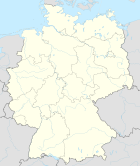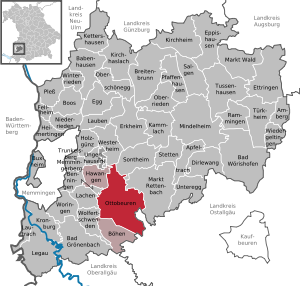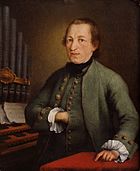Ottobeuren
| coat of arms | Germany map | |
|---|---|---|

|
Coordinates: 47 ° 56 ' N , 10 ° 18' E |
|
| Basic data | ||
| State : | Bavaria | |
| Administrative region : | Swabia | |
| County : | Unterallgäu | |
| Management Community : | Ottobeuren | |
| Height : | 669 m above sea level NHN | |
| Area : | 56.08 km 2 | |
| Residents: | 8416 (Dec. 31, 2019) | |
| Population density : | 150 inhabitants per km 2 | |
| Postal code : | 87724 | |
| Area code : | 08332 | |
| License plate : | MN | |
| Community key : | 09 7 78 186 | |
| Market structure: | 49 parts of the community | |
Market administration address : |
Marktplatz 6 87724 Ottobeuren |
|
| Website : | ||
| Mayor : | German Fries ( FW ) | |
| Location of the Ottobeuren market in the Unterallgäu district | ||
Ottobeuren is a market in the Upper Swabian district of Unterallgäu in Bavaria and the seat of the Ottobeuren administrative community , which also includes the communities of Böhen and Hawangen .
The place is best known for the Ottobeuren Benedictine monastery . Ottobeuren is industrial and as a sub-center, the market has the lower administrative level for the surrounding area.
geography
Ottobeuren is located about 10 kilometers southeast of Memmingen in the Donau-Iller region . The landscape is characterized by the curved relief that was formed by the gravel deposits during the last ice ages. The area belongs to Upper Swabia . The Westliche Günz runs through the municipality .
The lowest point in the municipality is 617 m above sea level. NHN in the valley of the western Günz northwest of Stephansried, the highest point at 834 m above sea level. NHN southeast of Neuvogelsang.
The municipality has 49 parts of the municipality (the type of settlement is given in brackets ):
|
|
|
|
The village of Obermotzen has gone .
The municipal area consists of the districts Ottobeuren, Betzisried, Guggenberg, Haitzen and Ollarzried as well as part of the district of Lachen (the other part of the district forms the municipality of Lachen ).
history
Until the 18th century
According to the legend, Ottobeuren was founded by a Uot around 550 as a clearing settlement and named after him Uotbeuren . In the 8th century the village became a Frankish imperial court and seat of Count Silach. The Benedictine monastery Ottobeuren was founded in 764. In 972 the monastery was elevated to an imperial abbey by Emperor Otto I. The church and monastery were rebuilt in the 11th century, and rebuilt after fires in the 11th and 12th centuries. In 1365 the abbey lost its independence and became part of the diocese of Augsburg . The Romanesque church was damaged in the German Peasants' War in the 16th century and rebuilt in the Renaissance style by 1558. The monastery was also damaged and looted during the Thirty Years' War .
After Abbot Rupert Neß was able to regain the imperial immediacy , the abbey began to completely rebuild the monastery complex in the baroque style in 1711. Finally, from 1737 to 1766, a large new monastery church (today's “basilica”) was built, completing the baroque “total work of art” Ottobeuren. Two years later, the millennium jubilee of the monastery could be celebrated in the new church in 1766.
19th and 20th centuries
In 1802 the monastery was transferred to the Kingdom of Bavaria as part of secularization . However, the convent of the Benedictine monastery continued to exist because the monks were allowed to stay in one wing of the monastery, but no new admissions were possible. Other parts of the monastery were u. a. used as a district court, barracks and for apartments. In 1834 the monastery was re-established under King Ludwig I as the priory of St. Stephen's Abbey in Augsburg, and in 1918 it became an independent abbey again . As the only one of the large Upper Swabian Baroque monasteries, Ottobeuren has a monastic tradition that has not been interrupted by secularization. About 20 Benedictine monks live there. The monastery complex is currently also used as a museum, school and training center. For the 1200th anniversary of the founding of the monastery, the church and monastery were extensively renovated in 1964. In 1952, large parts of the fairy tale dwarf nose were filmed in Ottobeuren .
The history of the market town of Ottobeuren is closely linked to that of the monastery. After secularization, the monastery church became the parish church of the market, the parish church of St. Peter was closed and later rebuilt as a school. Ottobeuren has been a recognized Kneipp spa since 1957, thus preserving the legacy of Pastor Sebastian Kneipp, who was born in the Stephansried district and grew up in Ottobeuren . Due to its proximity to the Allgäu holiday region, Ottobeuren markets itself with the slogan Allgäu for the senses .
Religions
In addition to the Roman Catholic parish with the basilica as a parish church, there is also a Protestant parish that holds its services in the Church of the Redeemer, built in 1957. The former Catholic parish church was converted into a spa house in the 20th century.
Incorporations
On January 1, 1972, the previously independent communities of Betzisried, Guggenberg and Haitzen were incorporated. Ollarzried was added on July 1, 1972. Parts of the neighboring community of Lachen followed on May 1, 1978 ( Niebers and Schiessenhof ).
Population development
Ottobeuren grew by 557 residents or a good 7% between 1988 and 2008. Between 1988 and 2018 the market grew from 7,466 to 8,381 inhabitants or by 12.3%. The population figures from 1840 onwards relate to today's municipality area (as of 1978).
| Population development | ||||||||||||||
|---|---|---|---|---|---|---|---|---|---|---|---|---|---|---|
| year | 1840 | 1900 | 1939 | 1950 | 1961 | 1970 | 1987 | 1988 | 1991 | 1995 | 2000 | 2005 | 2010 | 2015 |
| Residents | 3,195 | 3,897 | 4,488 | 7.165 | 6.156 | 6,709 | 7,317 | 7,466 | 7,722 | 7,936 | 7,986 | 8,042 | 7,935 | 8,170 |
politics
Municipal council
The first mayor of the community has been German Fries from the Free Voters since May 1, 2014; he was confirmed in office on March 15, 2020 with 84.9% of the votes.
The last municipal council election on March 15, 2020 brought the following result:
| Party / list | CSU | SPD | Free voters | Alliance 90 / The Greens | total |
| Seats | 8th | 2 | 7th | 3 | 20th |
coat of arms
The coat of arms was approved on January 4, 1938 by decree of the Reich Governor in Bavaria.
Blazon : “Split; in front in red half a silver eagle at the slit, at the back split by black and gold. "
The silver eagle on a red background has been the symbol of Ottobeuren Abbey since Abbot Wilhelm von Lustenau (1460–1473); the colors gold and black are taken from the former convent coat of arms and at the same time symbolize the former imperial immediacy of the Benedictine monastery.
The Ottobeuren market is the only municipality in the district that received a completely new municipal coat of arms after 120 years during the Third Reich. This process, which is quite unusual in heraldry, was due to the fact that, according to the will of the district judge of the Ottobeuren market in 1818, a split coat of arms with the Bavarian diamonds and a half silver eagle should be awarded with reference to the former imperial monastery Ottobeuren.
This commemoration of the monastery rule was not in keeping with the times for the rulers at the time, and a ban from 1818 on wearing the double-headed eagle of the former empire stood in the way. Ottobeuren thus received the coat of arms from the Bavarian State Ministry of Foreign Affairs, which shows “a gothic cathedral with two red-covered towers in a silver shield on a green background”.
The coat of arms was designed by the Schleißheim heraldist Otto Hupp .
flag
The flag was approved by decision of the government of Swabia on March 29, 1988. The flag is striped yellow and black with the municipal coat of arms.
Community partnerships
Ottobeuren has entered into a partnership with the following municipalities:
Norcia in Umbria , Italy
Saint-Donat-sur-l'Herbasse in the Drôme department , France
Tenterfield in New South Wales , Australia
![]()
![]()
![]()
Culture and sights
Ottobeuren as a whole is one of the main attractions on the eastern route of the Upper Swabian Baroque Route . The center of the place is the Ottobeuren monastery with the dominant late baroque basilica of St. Alexander and Theodor .
The Museum of Contemporary Art - Diether Kunerth , dedicated to the work of the Ottobeuren-based artist Diether Kunerth , opened on May 24, 2014 .
Right next to the Hotel am Bannwald is a Lourdes grotto from around 1885, above it a mount of olives with life-size cast iron figures. The stations of the cross have been dismantled and are waiting for a new installation.
The Allgäu public observatory in Ottobeuren , about one kilometer south of Ottobeuren, is the largest public observatory in Central Swabia / Allgäu and has a modern 60 cm telescope. There are regular public tours and special tours there.
Architectural monuments
Sports
One of the largest sporting events in the community is the “Ottobeuren Half Marathon”, which has been held regularly in March since 2012. Furthermore, a triathlon has been taking place in Ottobeuren every year for more than 30 years and is becoming increasingly popular.
Economy and Infrastructure
traffic
Ottobeuren is connected to the regional road network by several state roads , district roads and municipal roads. The state road St 2011 and the state road St 2013 intersect the northeast of the market. The district roads MN 18 and MN 31 run through the village . The place is connected by bus lines with Memmingen , Bad Grönenbach and Sontheim , where the nearest train stations are. The railway line from Ottobeuren to Ungerhausen was closed to regular passenger traffic in 1972, completely shut down in 1996 and converted into a cycle and walkway in 2009, the so-called DB-Günztal-Radweg , which runs along the western Günz in a northerly direction.
Local businesses
Ottobeuren is shaped by industry. In addition to the woodworking machine manufacturing company Otto Martin Maschinenbau GmbH & Co. KG , other companies have branches in the area: Berger Holding, based in Memmingen, and Otto Christ AG, based in Benningen .
tourism
Ottobeuren is a stop on several tourist routes. It is one of the main towns on the eastern route of the Upper Swabian Baroque Route , and is a neighboring town on the Swabian Baths Street , the Sebastian-Kneipp hiking trail, the Bavarian-Swabian St. James pilgrimage and the Mühlenstraße in Upper Swabia . For tourist reasons and because of the Allgäu brand , Ottobeuren uses the Allgäu slogan for the senses .
Healthcare
Ottobeuren is the location of the district clinic Ottobeuren belonging to the district of Unterallgäu. Until 2010, there was a TCM clinic, a hospital for traditional Chinese medicine, in the immediate vicinity of the district clinic.
Social facilities
In Ottobeuren and its districts there are five kindergartens, a youth center, the old people's homes St. Josef, Lebenszentrum and Hafner-Villa and a youth hostel run by the German Youth Hostel Association. In Böhen there is the Waldmühle youth center, a place to stay primarily for church groups.
education
The community has primary schools in Ottobeuren and Hawangen, a middle school, a school center with a secondary school and a grammar school (linguistic and scientific-technological branch, grades 5 to 10 and, since September 2009, also the upper school level) under joint management, an adult education center, a music school, a Catholic community library and an Evangelical parish library.
Personalities
Sons and daughters of the church
- Hans Scham (1588–1654), sculptor
- Johann Hiebel (1681–1755), painter
- Johann Michael Klein (1692–1767), Baroque master carpenter
- Karl Joseph Riepp (1710–1775), organ builder, born in Eldern
- Karl Honorat von Huber (1772–1857), administrative lawyer, President of the United Government and Chamber of the Principality of Hohenzollern-Sigmaringen
- August Prinzinger (1811–1899), lawyer and member of the Salzburg state parliament
- Sebastian Kneipp (1821–1897), pioneer of the water treatment, born in Stephansried
- Johann Michael Raich (1832–1907), theologian and dean of the cathedral in Mainz
- Theodor Breher OSB (1889–1950), Missionary Benedictine and Bishop of Yanji in China
- Luis Zett (1945–2017), composer and piano teacher
- Karl Schlögel (* 1948), historian, born in Hawangen
- Gisela Schütz-Gmeineder (* 1955), physicist
- Maxi Schafroth (* 1985), cabaret artist and actor
Other personalities
- St. Ulrich von Augsburg (890–973), abbot from 972 to 973
- Sel. Rupert I , († 1145), abbot from 1102 to 1145
- Rupert Neß (1670–1740), abbot from 1710 to 1740
- Anselm Erb (1688–1767), abbot from 1740 to 1767
- Franz Xaver Schnizer (1740–1785), monk and composer
- Johann Nepomuk Holzhey (1741–1809), German organ builder
- Father Ulrich Schiegg (1752–1810), mathematician, astronomer and surveyor; he succeeded in launching the first balloon in German-speaking countries in Ottobeuren
- Martin Egg (1915–2007), local poet
- Arthur Maximilian Miller (1901–1992), writer
- Diether Kunerth (* 1940), artist
Web links
- Entry on the Ottobeuren coat of arms in the database of the House of Bavarian History
- Ottobeuren: Official statistics of the LfStat (PDF file; 1 MB)
- High-resolution panorama picture of Ottobeuren
- Ottobeuren in pictures
literature
- Wolfgang Wüst: Environment and monastery - the hunting, forest and wood regulations of March 17, 1787 in Ottobeuren , in: Korbinian Birnbacher, Stephan Haering (ed.): Germania Monastica. Festschrift for Ulrich Faust OSB for his 80th birthday (StMGB - Studies and Communications on the History of the Benedictine Order and its Branches 126), St. Ottilien 2015, English abstract, pp. 373-390, ISBN 978-3-8306-7740-6
- Abbot Johannes Schaber OSB (text and photos): “This place is holy” - The Benedictine abbey Ottobeuren in pictures , 284 pages, 415 illustrations, 1st edition 2019, Kunstverlag Josef Fink , ISBN 978-3-89870-918-7
Individual evidence
- ↑ "Data 2" sheet, Statistical Report A1200C 202041 Population of the municipalities, districts and administrative districts 1st quarter 2020 (population based on the 2011 census) ( help ).
- ↑ Center map on the Donau-Iller region website ( Memento from June 13, 2010 in the Internet Archive )
- ↑ Joachim Jahn (ed.): The history of the city of Memmingen , Vol. 1: From the beginnings to the end of the imperial city . Theiss, Stuttgart 1997, ISBN 3-8062-1315-1 , mentions the “Upper Swabian Ottobeuren Monastery” several times.
- ↑ Municipality of Ottobeuren in the local database of the Bavarian State Library Online . Bavarian State Library, accessed on August 15, 2019.
- ^ Wilhelm Volkert (ed.): Handbook of Bavarian offices, communities and courts 1799–1980 . CH Beck, Munich 1983, ISBN 3-406-09669-7 , p. 521 .
- ^ Federal Statistical Office (ed.): Historical municipality directory for the Federal Republic of Germany. Name, border and key number changes in municipalities, counties and administrative districts from May 27, 1970 to December 31, 1982 . W. Kohlhammer, Stuttgart / Mainz 1983, ISBN 3-17-003263-1 , p. 783 .
- ↑ Second votes, according to the source www.wahlen.bayern.de, accessed on March 4, 2018
- ↑ http://blitzkunst.wordpress.com/2014/05/26/wie-man-als-kunstler-sein-eigenes-museum-bekommen
- ↑ Home. Retrieved June 28, 2020 .
- ↑ Constantin von Wurzbach : Hiebel, Johann . In: Biographisches Lexikon des Kaiserthums Oesterreich . 9th part. Imperial and Royal Court and State Printing House, Vienna 1863, p. 5 ( digitized version ).









